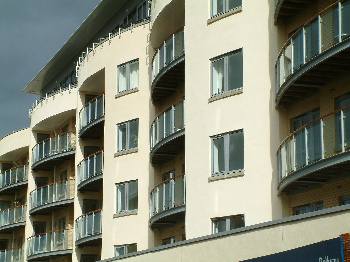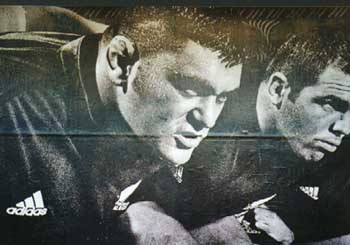Native Cardiffian Peter Finch's view of some of the
dramatic changes going on in his city. Is the city all drink and glass?
Who needs it? What chances are there for the capital of Wales in the
twenty first century? Is Cardiff now a Celtic Faliraki or Ag Nik?
In the city that never sleeps - 24-hour supermarkets, 24-hour burger
bars, 24-hour clubs is there room for culture? Is this Independent Tropical
Wales or a manufactured aberration? Do read on.

Somewhere in the middle of the nineteen-nineties in one of those
vox pop polls beloved of the tabloids, Cardiff got itself voted as
'most desirable destination' in the UK or something like that. "Cardiff
is the new rock and roll", remarked one chubby-faced fresher from
the East Midlands, displaying that innovative turn of phrase that
only the English possess. "It's the place where it all happens." The
description has stuck.
This is not a Welsh perception, naturally, far from it. For most
of the Welsh population Cardiff remains a centre for permanent suspicion.
It is regarded as too English, too distant, too flash, too fast, too
large and far too anti-Cymraeg for many. Half of its population still
think they live in the West Country. The rest don't care. Nevertheless,
the excitement of being one of the newest of European capitals hangs
light in the air. All you have to do is stand in the middle of Queen
Street and look at the place. Something is going on - and going on
at a considerable rate. But we're not quite sure what it is, are we,
Mrs Jones?
Cardiff is a post-industrial city. There was a time - one which
many who live here now can still remember - when the place stank permanently
of coal, fume and ash. The vast East Moors steel works at its centre
turned the air dark. Most of the south Wales valleys' coal output
clanked its way through the city's heart to leave through its port.
Cardiff was a place of smog and dark sunrises. But all that has gone.
Its residue flattened and built on. The stonework has been washed
and the streets are full of trees. Cardiff is now a city of call-centres,
leasing agents, insurance companies, utility providers, transport
undertakings, media hqs, plc head offices, government centres, banks
and building societies. Hardly anyone gets their hands dirty. There
are lots of suits and cell-phones. It is a metropolis. These are rare
in Wales.
Cardiff has been the Welsh capital since 1955 when it saw off Wrexham,
Aberystwyth and a few other pale pretenders. It is also the site of
the National Assembly despite the population overwhelmingly voting
against having one in 1998. This piece of disingenuousness is shrugged
off by many locals who have now embraced Welshness totally, rather
in the style of Shirley Bassey, and can be observed flying the Ddraig
Goch from the back of their taxis and sticking croeso on their shop
front doors. Wales' new nation status has given Cardiffians an alternative
big brother to next door England. Now there is also Europe. The English
may be reluctant these days to say who they are but we, almost xenophobically,
are not. Our sense of identity is vivid. We wear it well.
Nonetheless Cardiff does not feel a very Welsh place despite the
bilingual street signs and the willingness of the Halifax Building
society to take your money from you yn Gymraeg. The city is overtly
multi-cultural with, for Wales, a large percentage of Asians, afro-Caribbeans
and significant enclaves from Somalia and Yemen. You can go out at
night and listen to bhanghra music and there are cinemas that show
nothing but Asian films. The University attracts Arabs and Iranians
like a magnet and the centre streets can be full of dark, well dressed
students with chador-clad women in tow. You can take a stroll down
Queen Street of a Saturday and in quick succession be converted by
charismatic Methodists, Moonies, Hare Krishnas and evangelical Muslims.
Against this background it is difficult to believe that Cardiff is
actually home to more Welsh speakers than anywhere in Gwynedd. When
you leave home for the bright lights in Wales you don't go to Aberystwyth
or Swansea, you come here.
Simple urban redevelopment, however, is not new nor in any way unique
to the Welsh capital. Both Swansea and Merthyr have been completely
rebuilt and in Merthyr's case so well that the past there is now extremely
hard to find. What is different in Cardiff is the combination of imagination
and scale. Twenty years ago, well before identity took over as a driving
force and the city slumbered with an old-fashioned museum, shows at
the Sherman Theatre and films & exhibitions at an old school converted
into art centre, the decision was taken. The money was found. One
of Europe's largest inner-city regeneration projects was born.
St David's Hall, a genuine concert hall with a working acoustic
shell, was erected opposite the old central library (later to become
the short-lived Centre For The Visual Arts and now a visitor
centre and on target to become the City's museum); the city centre
was comprehensively pedestrianised and kitted out with the best shopping
malls east of New York; and the Cardiff Bay Development Corporation
was brought into being. This often controversial quango - now wound
up, its work completed, its powers gone back to Cardiff County Council
- was given £2.5 billion pounds to redo what looks to the casual observer
like the entire south of the City. The marketeers took over. What
was the Docks became Cardiff Bay. This was much to the annoyance of
locals who continue to call the place what they always have - Butetown.

New apartments
cream and glass
all facing the sea
£350,000 waterside penthouses have gone up in places redesignated
with marketable names like Adventurers Quay, the Sand Wharf, Sovereign
Quay, and Rigarossa. A five-star hotel has been built on the waterfront
(like the Hall also named St David's to capitalise on the reputation
of a saint who never actually came here). A new grand boulevard -
Lloyd George Avenue - has gone in behind the railway along which traffic
now sweeps from the glittering city centre to the red brick Pier Head
and the glories of the all-glass transparency of the Senedd - the
National Assembly debating chamber. This is a new parliament for Wales
with space and sweep and steps to the sea. The Wales Millennium Centre
- Jonathan Adam's splendid slate and heritage coast concert hall,
opera house, and international arts complex - stands the Senedd's
north. Like a vast helmet it dominates everything. The WMC houses,
among others, the Welsh National Opera, Touch Trust, Ty Cerdd,The
Urdd, Diversions Dance, The Academi and HiJinx Theatre. It has a text
composed by poet Gwyneth Lewis across its front formed from windows
15 feet high celebrating our literary present. The area is thick with
corporate new millennium headquarters. Glass, light, style. And there
is copious supply of cafes, bars, gourmet-class restaurants, galleries,
and open air coliseums. People flock. The concept works.

Poster advertizing Rizla on Queen Street Station